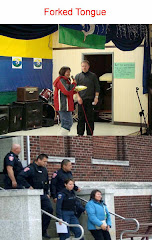model of what usually happens in disputes that are resolved.
1. A Conflict
2. A Moratorium, Cease-fire, Suspension of Hostilities or Pause.
3. A jointly agreed independent body/person conducts collaborative
research with the parties to the dispute and makes recommendations.
4. Recommendations lead to a negotiated resolution of the dispute.
5. Peace is Restored.
What went wrong at KI?
A conflict developed between Platinex and KI. Rather than a moratorium
being declared Platinex went to court and sued KI for $10 billion and
access to the land. KI defended and counterclaimed ultimately winning a
court imposed pause( the interim, interim order) for negotiations.
It is at this point that some independent assessment should have
occurred or the pause turned into a moratorium and a panel appointed.
Instead we had positional bargaining by Ontario and Platinex that
sought to have drilling at all costs and to minimize the legal damage
that the first KI victory meant for free entry and the Mining Act.
KI was the only party with an interest in any kind of independent
assessment.And it was the party with the least resources.The playing
field was far from level.
KI put forward some very reasonable positions in the discussions on the
need for various environmental, cultural, community health and other
studies that considered the dispute in the wider context of strategic
land use planning, the unresolved KI land claim and protecting options
for the children of the future.
The KI approach was rejected by Platinex and Ontario and the talks
foundered over issues of funding and approach to resolving the problem.
All this occurred under the shadow of the lawsuit which coloured the
dispute, increased suspicion and hostility between the parties and
required incredible amounts of money for legal advice.
Ontario and Platinex would not move off their position that defined the
discussions solely in terms of the staging of drilling and measures to
mitigate a very narrow set of KI concerns.
Ontario and Platinex had no interest in change. Their interests were
defensive. For Ontario, to protect the Mining regime in Ontario from
further damage by First Nation interests. And for Platinex to get on
the land and drill.
Ontario and Platinex had no interest in any studies that would have
made the KI No reasonable and they made sure that no studies were ever
carried out.
KI had no resources to conduct its own studies and any resources they
did have were needed to defended against the paper and legal motion war
of their opponents, Ontario and Platinex.
Inevitably Platinex returned the dispute to Court, and with the help of
Ontario, convinced the judge to impose the MOU that required drilling.
Some claimed a minor victory for first nations in that the imposed
early exploration agreement further damaged the mining regime in
Ontario. It is beyond argument that agreements must be made with First
Nations at the early exploration stage and that the Mining Act must be
changed to reflect the new legal reality of First Nation rights.
However the need for an early exploration deal provides no help to
those communities who want the right to say no.
No independent studies were ever carried out. There was no independent
technical review of the Platinex project or review of the information
provided by Ontario. The entire intellectual effort went to the
wordings of various consultation protocols and MOU's.
Time was now on Ontario's side. It now became a contest of wills, with
the Courts acting to enforce the will of Ontario and Platinex onto KI.
It was only a matter of time before KI would face a contempt motion.
The motion came, KI did not defend and the KI six were jailed.
The lesson here is that we must return to the five stage solution
sequence and begin again. Not with a lawsuit driving the agenda and
forcing the parties into positions, but with a moratorium and an
independent body.
Just happens to be the KI proposal.




